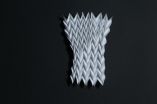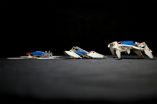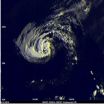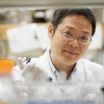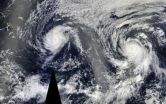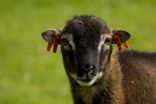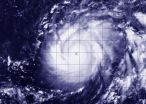(Press-News.org) Researchers are a step closer to understanding the birth of the sun.
Published in Science, the team led by Dr Maria Lugaro and Professor Alexander Heger, from Monash University, have investigated the solar system's prehistoric phase and the events that led to the birth of the sun.
Dr Lugaro, from the Monash Centre for Astrophysics, said the team used radioactivity to date the last time that heavy elements such as gold, silver, platinum, lead and rare-earth elements were added to the solar system matter by the stars that produced them.
"Using heavy radioactive nuclei found in meteorites to time these final additions, we have got a clearer understanding of the prehistory of the solar system," Dr Lugaro said.
"We can now tell with confidence the final one per cent of gold, silver and platinum, were added to the solar system matter roughly 100 million years before the birth of the sun.
"The final one per cent of lead and rare-earth elements, such as those that make your smart phone, was added much later - at most, 30 million years before the birth of the sun."
Dr Lugaro said the detailed timing opened up new opportunities to understand the series of events that led to the formation of the sun.
Some time after the last addition of heavy elements the solar system matter went into an 'incubation' period, during which time the stellar nursery formed - where the sun was born together with a number of other stars.
"We now know this incubation period could not have lasted more than 30 million years. This offers us the chance to determine the lifespan of the nursery where the sun was born, how massive it was and how many stars were born there together," Dr Lugaro said.
"Ultimately, we want to have a clear understanding of the circumstances of the birth of our star and the prehistory of the solar system.
"Understanding the timescales and processes leading to the formation of our solar system is key to relate its birth environment with that of other planetary systems in the galaxy."
Dr Lugaro said the research team would now be looking at other heavy radioactive nuclei to get more understanding of the prehistory of the solar system, and improve the accuracy and precision of the timing.
INFORMATION:
Dr Lugaro and Professor Heger completed the research with the help of a third year student, Dean Osrin. It also included researchers from the University of West Hungary, the Universite' Libre de Bruxelles, the University of Dresden, the Australian National University, and the University of Central Lancashire.
For more information please contact Rachael Fergusson, Monash Media & Communications +61 3 9903 4841
Step closer to birth of the sun
2014-08-07
ELSE PRESS RELEASES FROM THIS DATE:
Finding the genetic culprits that drive antibiotic resistance
2014-08-07
Researchers have developed a powerful new tool to identify genetic changes in disease-causing bacteria that are responsible for antibiotic resistance. The results from this technique could be used in clinics within the next decade to decide on the most effective treatments for diseases such as pneumonia and meningitis.
The team looked at the genome of Streptococcus pneumoniae, a bacterial species that causes 1.6 million deaths worldwide each year. In the most detailed research of its kind, scientists used a genome-wide association study (GWAS) to locate single-letter ...
Learning from origami to design new materials
2014-08-07
AMHERST, Mass. -- A challenge increasingly important to physicists and materials scientists in recent years has been how to design controllable new materials that exhibit desired physical properties rather than relying on those properties to emerge naturally, says University of Massachusetts Amherst physicist Christian Santangelo.
Now he and physicist Arthur Evans and polymer scientist Ryan Hayward at UMass Amherst, with others at Cornell and Western New England University, are using origami-based folding methods for "tuning" the fundamental physical properties of any ...
Robot folds itself up and walks away
2014-08-07
A team of engineers used little more than paper and Shrinky dinks™ – the classic children's toy that shrinks when heated – to build a robot that assembles itself into a complex shape in four minutes flat, and crawls away without any human intervention. The advance, described in Science, demonstrates the potential to quickly and cheaply build sophisticated machines that interact with the environment, and to automate much of the design and assembly process. The method draws inspiration from self-assembly in nature, such as the way linear sequences of amino acids fold into ...
Origami robot folds itself up, crawls away
2014-08-07
For years, a team of researchers at MIT and Harvard University has been working on origami robots — reconfigurable robots that would be able to fold themselves into arbitrary shapes.
In the August 7 issue of Science, they report their latest milestone: a robot, made almost entirely from parts produced by a laser cutter, that folds itself up and crawls away as soon as batteries are attached to it.
"The exciting thing here is that you create this device that has computation embedded in the flat, printed version," says Daniela Rus, the Andrew and Erna Viterbi Professor ...
NASA sees heavy rainfall in Iselle as the hurricane nears Hawaii
2014-08-07
VIDEO:
TRMM satellite rainfall data overlaid on an enhanced infrared image from NOAA's GOES-West satellite shows heavy rainfall occurring around the Iselle's eye. The most intense rain was falling at a...
Click here for more information.
A NASA satellite has observed heavy rainfall in Hurricane Iselle on its approach to Hawaii. NASA's TRMM Satellite captured rainfall rates within the storm as it passed overhead. In addition, NASA's Aqua satellite provided a larger view of the Central ...
Cell signaling pathway linked to obesity, type 2 diabetes
2014-08-07
WEST LAFAYETTE, Ind. - A Purdue University study shows that Notch signaling, a key biological pathway tied to development and cell communication, also plays an important role in the onset of obesity and Type 2 diabetes, a discovery that offers new targets for treatment.
A research team led by Shihuan Kuang, associate professor of animal sciences, found that blocking Notch signaling in the fat tissue of mice caused white fat cells to transform into a "leaner" type of fat known as beige fat. The finding suggests that suppressing Notch signaling in fat cells could reduce ...
Gut microbes browse along a gene buffet
2014-08-07
DURHAM, N.C. -- In the moist, dark microbial rainforest of the intestine, hundreds of species of microorganisms interact with each other and with the cells of the host animal to get the resources they need to survive and thrive.
Though there's a lot of competition in this vibrant ecosystem, collaboration is valued too. A new study on the crosstalk between microbes and cells lining the gut of mice shows just how cooperative this environment can be.
One of the main ways that hosts manage their interactions with microbes is by carefully controlling the genes that their ...
NASA sees Hurricane Julio organize and emit a gamma-ray flash
2014-08-07
NASA's Fermi and Aqua satellites captured two different views of bursts of strength show by Hurricane Julio as it intensified. NASA's Fermi satellite saw a gamma-ray flash from Julio, while NASA's Aqua satellite saw Julio become more structurally organized as a hurricane.
This type of outburst is known as a terrestrial gamma-ray flash (TGF). Produced by the powerful electric fields in thunderstorms, TGFs last only a few thousandths of a second but emit gamma rays that make up the highest-energy naturally-occurring light on Earth. Scientists estimate that, on average, ...
Wild sheep show benefits of putting up with parasites
2014-08-07
In the first evidence that natural selection favors an individual's infection tolerance, researchers from Princeton University and the University of Edinburgh have found that an animal's ability to endure an internal parasite strongly influences its reproductive success. Reported in the journal PLoS Biology, the finding could provide the groundwork for boosting the resilience of humans and livestock to infection.
The researchers used 25 years of data on a population of wild sheep living on an island in northwest Scotland to assess the evolutionary importance of infection ...
NASA sees Genevieve cross international date line as a Super-Typhoon
2014-08-07
Tropical Storm Genevieve had ups and downs in the Eastern Pacific and Central Pacific over the last week but once the storm crossed the International Dateline in the Pacific, it rapidly intensified into a Super Typhoon. NASA-NOAA's Suomi NPP satellite captured of the storm.
When Suomi NPP flew over Genevieve on August 7 at 01:48 UTC the Visible Infrared Imaging Radiometer Suite (VIIRS) instrument aboard captured an infrared image of the storm. VIIRS collects visible and infrared imagery and global observations of land, atmosphere, cryosphere and oceans. VIIRS flies aboard ...
